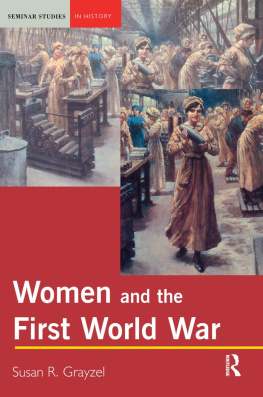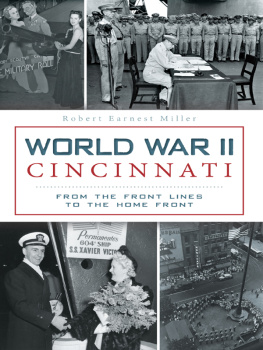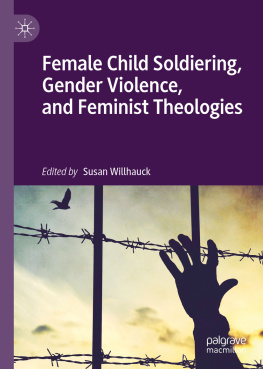1999 The University of North Carolina Press
All rights reserved
Manufactured in the United States of America
Set in Monotype Garamond and Gill types by Tseng Information Systems
The paper in this book meets the guidelines for permanence and durability of the Committee on Production Guidelines for Book Longevity of the Council on Library Resources.
Library of Congress Cataloging-in-Publication Data
Grayzel, Susan R.
Womens identities at war : gender, motherhood, and politics in Britain and France during the First World War / by Susan R. Grayzel.
p. cm.
Includes bibliographical references and index.
1. World War, 19141918WomenGreat Britain. 2. World War, 19141918WomenFrance. 3. WomenIdentity. 4. WomenGreat BritainHistory20th century. 5. WomenFranceHistory20th century. I. Title.
D810.W7G665 1999
94053082dc21 9847607
CIP
03 02 01 00 99 5 4 3 2 1
Some material in Chapters 3, 4, and 6 previously appeared in somewhat different form in the following articles:
The Enemy Within: The Problem of British Womens Sexuality during the First World War. In Women and War in the 20th Century: Enlisted with or without Consent, ed. Nicole Dombrowski (New York: Garland Press, forthcoming). Used with permission of the editor and Garland Press.
Mothers, Marraines and Prostitutes: Morale and Morality in First World War France, International History Review 19, no. 1 (Feb. 1997). Used with permission of the editors.
The Mothers of Our Soldiers Children: Motherhood, Immorality, and the War Baby Scandal, 19141918. In Maternal Instincts: Motherhood and Sexuality in Britain, 18751925, ed. Claudia Nelson and Ann Sumner Holmes (Houndsmills, Hampshire: Macmillan, 1997). Used by the permission of Macmillan Press.
The Outward and Visible Sign of Her Patriotism: Women, Uniforms, and National Service during the First World War, 20th Century British History 8, no. 2 (1997). Used by the permission of Oxford University Press.
ISBN-13: 9780-80782482-5 (cloth : alk. paper)
ISBN-13: 9780-80784810-4 (pbk. : alk. paper)
Acknowledgments
This book is the culmination of my attempts to answer questions that I have been pondering since I was an undergraduate, although not in any way a definitive answer to them. In that sense, it owes its existence to historical circumstances (the creation of Greenham Common and the revival of the feminist peace movement in the 1980s, for instance, which sparked a series of ongoing personal, political, and intellectual interests) and to the generosity of many individuals.
I want first to thank the following institutions for the support that enabled this work. I am most indebted to the University of California at Berkeley, its graduate division, and especially its department of history for funding the bulk of the original research. And at later stages, the Andrew J. Mellon Foundation gave me the gift of a year for writing and revision; a Bernadotte E. Schmitt Grant from the American Historical Association allowed for follow-up research; and the University of Mississippi helped to insure its completion. Funds from the University of Mississippis Ventress Order subsidized the cost of the illustrations. I am grateful to all.
I am delighted that I can finally thank Joe Boone, Judy Coffin, and Deb Nord for their teaching and their support that led me to decide to enter graduate school and that I can acknowledge my long-standing debt to Susan Pedersen; from the time that she, as a graduate student, advised my senior thesis, she has both taught me and shown me how to be a historian.
Beyond its financial support, Berkeley provided a wondrous environment for an apprentice historian, and I am grateful for all I learned from my inspiring teachers and fellow graduate students. Most especially, I thank Tom Laqueur, who has tolerated my ongoing need for advice by reading many drafts with patience, good humor, and astonishing critical insight. I also owe a great deal to Susanna Barrows, who actively encouraged my journey across the English Channel and shared her knowledge of France and the Third Republic with me, and to Mary Ryan, for her example and for teaching me how to think about gender and womens history across national boundaries. And only Sue Schweik herself knows how much her powers of critical analysis definitively shaped the discussions of gender and the literature of war that follow.
I am grateful to the staffs of all the many archives, institutions, and libraries where I conducted research, but I must single out those at the interlibrary loan office of the J. D. Williams Library at the University of Mississippi; at the Hoover Institution Library at Stanford University; at the Archives de la Prfecture de Police, the Bibliothque Marguerite Durand, Institut Franais dHistoire Sociale, and the Salle des Priodiques at the Bibliothque Nationale; at the Public Record Office; at the Fawcett Library, especially David Doughan; and above all at the Imperial War Museum, especially Nick Hewitt, Michael Moody, Catherine Moriarty, and Mary Wilkinson.
I am also profoundly appreciative of the many scholars who offered advice and often more direct assistance at the various stages and on various drafts and pieces of this project, most particularly: Stphane Audoin-Rouzeau, Lisa Cody, Deborah Cohen, Alice Conklin, Nicole Dombrowski, Jean Gallagher, Nicky Gullace, Ruth Harris, Ann Sumner Holmes, Chris Johnson, Susan Kent, David Kuchta, Sheryl Kroen, Donna Landry, Philippa Levine, Laurie McLary, Laura Mayhall, Claudia Nelson, Maura OConnor, Julian Putkowski, Lou Roberts, Lynn Sharp, Len Smith, Regina Sweeney, Sandra VanBurkleo, Jessica Weiss, Julie Wheelwright, Jay Winter, Angela Woollacott, and members of writing groups at the University of California at Berkeley, the University of Michigan, and the University of Mississippi. I am especially grateful to Laura Downs and William Irvine for their astute comments at a critical stage, and to Sonya Rose, for her insights and encouragement. For their interest and aid in transforming this project into a book, my thanks to the staff at the University of North Carolina Press, especially, Lewis Bateman, Mary Caviness, Mary Laur, and the two readers for the Press.
I also want to thank my supportive colleagues in the department of history at the University of Mississippi, and the students I have taught here, at the University of Michigan at Ann Arbor, and the University of California at Berkeley for reminding me why I am writing this book and making me think harder about how my work fits into the broad trajectory of modern European history.







